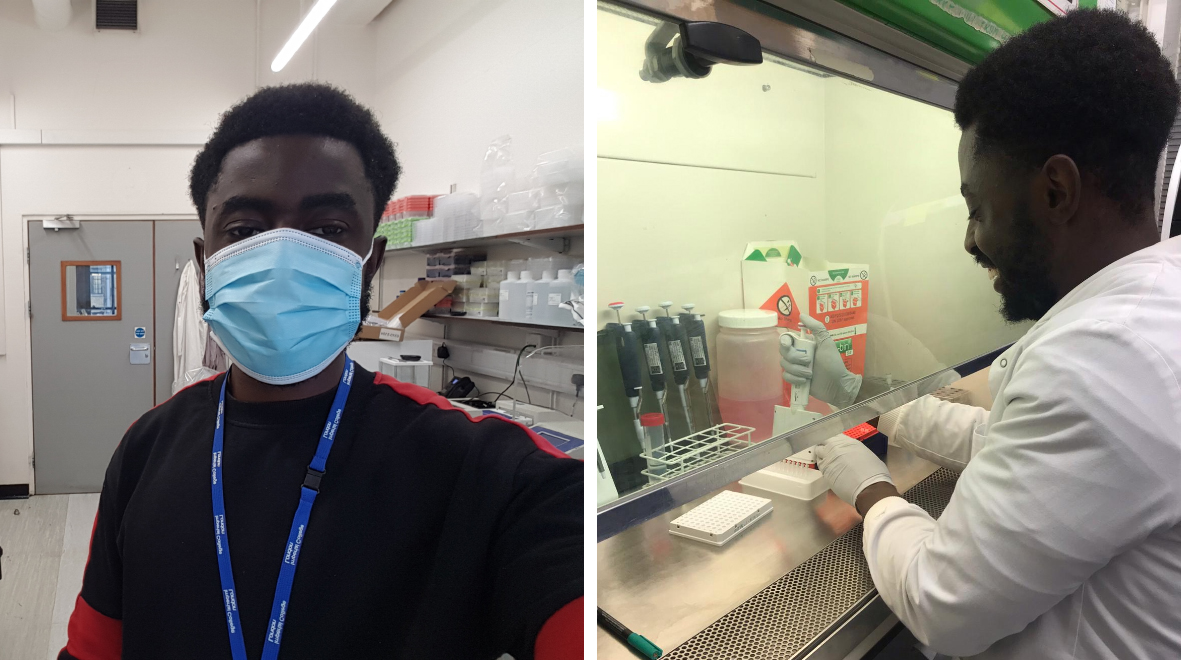
Recent graduate Samuel Badru is part of the lab team analysing samples for Imperial’s in-house Covid-19 testing scheme – here he shares the steps to processing a successful test.
I would have never guessed that five months into studying a Master’s in Molecular Biology and Pathology of Viruses, the world would be stopped in its track on account of a virus. Lockdown descended on the nation two weeks into my project, which for me meant more bioinformatics from home and no more laboratory work. Little did I know that I would return to St Mary’s Campus’ laboratories to assist in the effort to combat the COVID-19 pandemic!
I joined the College’s in-house SARS-Cov-2 testing team in October 2020 – the day after my results day (which went well!). There are a number of steps to the testing workflow that definitely seemed overwhelming at first, but after more than two months in it is all pretty much second nature.
Steps to successful tests
We receive throat swabs in specimen tubes – filled with a viral transport medium – from asymptomatic staff and students at Imperial, as well as from COVID-19 research studies (e.g. INSTINCT). Currently this can be up to 500 samples a day and is expected to increase once we start conducting pillar 2 community testing in January.
Then the sample viral transport medium is pipetted into plates that have 96 wells for up to 92 samples and four controls. Collected samples must be counted in order to know how many columns are needed on each 96-well plate. Once this is decided, lysis buffer is pipetted into the appropriate wells, and the plate and samples are taken into the containment laboratory, where we get to put on our PPE armour and feel important! Here we have a ‘buddy system’ where one pipettes the viral transport medium from each sample into a well, where any potential virus is inactivated by the lysis buffer. Concurrently, the buddy logs the position of each sample into the Laboratory Information Management System by scanning the unique barcode on each tube.
It is critically important at this stage to avoid contamination so that staff and students get accurate results. One way we avoid false-positive results is by wiping the pipette with Distel (High-Level Medical Surface Disinfectant) after each sample is pipetted into its well. Moreover, at this stage, we have to add two controls to the plate, which increases the reliability that ‘Detected’ results are truly positive and ‘Not detected’ results are truly negative.
Robots lend a helping hand
While this is taking place in the containment lab, other team members will be preparing up to six other plates that each will have a certain reagent needed for RNA extraction. All seven plates are loaded onto a high-throughput liquid-handling robotic platform, named Felix, that automates the pipetting process of RNA extraction. This device saves laboratory-space and is reagent-agnostic, which allows us to adapt and use other reagent kits – vital in this pandemic where there may be a high-demand/low-supply of a certain brand.
Most importantly, this automation saves a lot of time, allowing us to get people back their results in less than 24 hours, as well as increase the capacity of people that can get a test. While this automation takes place we prepare a PCR mastermix and pipette into a PCR plate. After the robot has finished, we add the eluted washed viral RNA into the PCR plate, as well as two additional controls to add further accuracy to the results. The plate is loaded onto one of our three PCR machines, where genomic material is amplified. We target two genes: the E-gene of SARS-Cov-2 to detect viral presence, and the human RNAaseP gene to know if swab samples were adequately taken.
Rewarding experience
It is gratifying knowing the work I am doing is enabling people with the knowledge they need to protect their own wellbeing, and that of their friends, families and communities. Particularly now, with infection rates so high, our UKAS-accredited tests are imperative in facilitating staff and students required on campus to return safely. Moreover, conducting tests for research studies is bringing clarity to the epidemiology of COVID-19, which in turn informs government policy pertaining to advised isolation duration for instance. It has been a pleasure collaborating with fellow scientists that are as equally motivated to help control the spread of the virus and ultimately save lives.
Samuel Badru has an MSc in the Molecular Biology & Pathology of Viruses from Imperial College London and a BSc (Hons) degree in Biomedical Sciences from The University of Manchester. From the latter, he spent his placement year in the microbiology department of Chiang Mai University in Thailand, where he published a first-author paper on his work with gastroenteritis viruses.